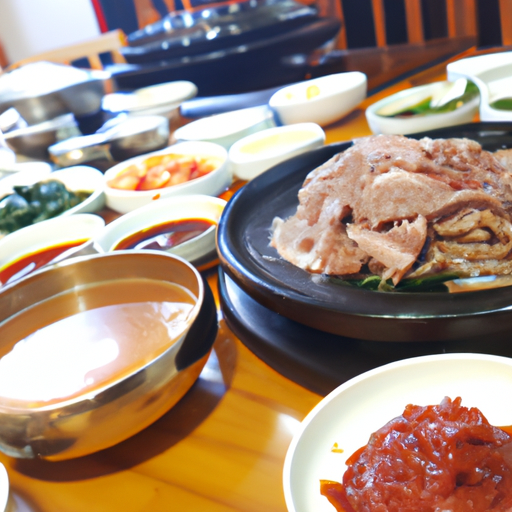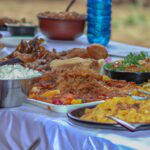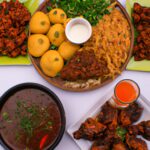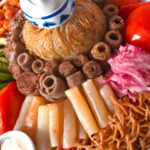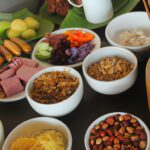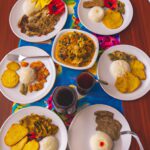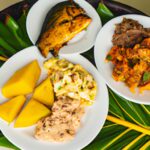Local Food and Cuisine in Korea (South)
Korea (South)is home to a wide array of delicious dishes and tantalizing flavors that will excite your taste buds! From fiery stews steeped in gochujang (red chili pepper paste) to sweet, succulent barbecued meats, the country’s cuisine is diverse and full of flavor. Whether you’re looking for street food snacks or something more filling, there’s something for everyone in Korea!
- Introduction of Food in Korea (South)
- Must try Local Cuisine in Korea (South) (Top 5)
- Weather in Korea (South)
- Hotels Korea (South)
- Reviews and Stories from Korea (South)
- About – Seoul the capitol of Korea (South)
- Popular Questions about Korea (South)’s local dishes
- 1. What are some of the most popular dishes in Korea?
- 2. What makes Korean food unique and flavorful?
- 3. Is there a difference between North and South Korean cuisine?
- 4. Are there any special ingredients used in traditional Korean recipes?
- 5. Is it easy to find vegan options when eating out in South Korea? ?
There are so many things types of amazing food in Korea (South), Asia we couldn’t list them all but we want to highlight 5 popular dishes from Korea (South) to give you a feel of what to expect. If you think we have missed anything major or if your favourite local food is not in the list let us know and we would be happy to add it to our travel guide.
Popular Foods in Korea (South)
- Kimchi in Korea (South)
- Bibimbap in Korea (South)
- Bulgogi in Korea (South)
- Sundubu-jjigae in Korea (South)
- Japchae in Korea (South)
Kimchi in Korea (South) – Kimchi is a traditional Korean dish made up of fermented vegetables. This spicy and savoury treat is usually made with cabbage, radish, or cucumber, and contains garlic, ginger, scallions and chili peppers for an extra kick. Kimchi has been eaten in Korea since ancient times and it is considered to be one of the healthiest dishes in the world. It’s high in vitamins A & C as well as probiotics that help keep your gut healthy. The flavour is bold but balanced with just the right amount of spiciness – making it perfect for adding some zing to sandwiches or soups!
Bibimbap in Korea (South) – is a traditional Korean dish made of steamed white rice, vegetables like spinach and bean sprouts, beef or other proteins, and a fried egg. Bibimbap comes together with the help of gochujang – a spicy red chili paste – which creates an unforgettable flavor profile that will tantalize your tastebuds. The combination of textures from the crunchy vegetables to the creamy egg mixed over chewy rice makes for an incredibly satisfying meal. Bibimbap has been around since ancient times in Korea when it was served during special occasions as part of ancestral ceremonies. Today, bibimbap continues to be enjoyed by millions around the world as one of Korea’s most beloved dishes!
Bulgogi in Korea (South) – is a popular Middle Eastern salad of chopped vegetables and toasted pita bread. It’s zesty flavor comes from the combination of lemon juice, olive oil and sumac – a tart, reddish-purple spice. This flavorful dish dates back to ancient times when it was enjoyed by Bedouins in the desert as they traveled across the region. Fattoush has a crunchy texture with each bite bringing out more of its delicious flavors. With juicy tomatoes, cucumbers and herbs, this easy-to-make salad is sure to tantalize your taste buds!
Sundubu-jjigae in Korea (South) – is a traditional Korean stew. It’s made with soft tofu, or sundubu, and an array of vegetables and mushrooms in a spicy broth. The flavor of this dish is both savory and slightly sweet thanks to the addition of garlic, scallions, onions and even some seafood like shrimp or clams. Sundubu-jjigae has been popular for centuries as it can be easily prepared with ingredients found in most Korean homes. It remains one of the favorite comfort foods today because it combines so many amazing flavors that tantalize your taste buds without being overwhelmingly spicy.
Japchae in Korea (South) – is a traditional Korean dish made with stir-fried sweet potato noodles and vegetables. The chewy texture of the noodles contrasts nicely with the crunchy texture of the carrots, onions, and mushrooms that are usually added to it. It’s often served at special occasions such as weddings or birthdays due to its vibrant colors and festive appearance. But japchae isn’t just about looks – it also has an unforgettable flavor! The combination of sesame oil and soy sauce creates a savory umami taste that lingers on your tongue long after you’ve taken your last bite.
Weather Korea (South)
When booking a holiday in Korea (South) one of the main things to look at is what the weather will be like when you get there. Due to these common weather questions, we have created a separate page talking about what the Whats the weather like in Korea (South)?. This included a month-by-month breakdown of what the weather is like and questions travellers have had regarding the climate.
LANDMARKS IN Korea (South)
After the weather and food, our attention normally turns to what is there to do in Korea (South) or what’s worth visiting. We have created a list of landmarks, places or interests and attractions to get your travel journey started – What tourist attractions are in or near Korea (South)?
Hotels in Korea (South)
Finally, after reading about Korea (South)’s weather, food, and tourist destinations, you might want to spend some time reading about the best hotels in Korea (South). Hotel information is always changing so please let us know if any of our reviews need updating and please feel free to share your stories and reviews from hotels you visit in both Korea (South) to help others on their travels. Also, feel to check out our hotel map from Booking.com to quickly find a hotel in Korea (South)
The Capitol of Korea (South) is – Seoul
When heading off to a country for the first time it’s always a good idea to read up on the capital city. and we have prepared a short guide about the captiol – Seoul to get you started.
Stories and Reviews from Our Team/Clients in Korea (South)
Korea (South)
I’m in South Korea and I know one thing for sure; the food is incredible! Everywhere I turn, there’s something new to discover. From traditional Korean dishes like bibimbap and bulgogi to street snacks like tteokbokki, it’s all delicious.
The first dish I tried was bibimbap. It’s a bowl of rice topped with a variety of vegetables, meat, egg, and gochujang (spicy red chili paste). The flavors were amazing – sweet from the carrots and radish that were cooked just enough
Do you have a story to share about a visit to – Seoul or Korea (South)? We would love to hear about it and add it here! Please feel free to comment at the bottom of this page or fill in our contact form.
Frequently Asked Questions About – Seoul, Korea (South)
Here at Tuchman Travel Guide, we are always trying to help if you have a question about an upcoming trip that our site does not answer just leave a comment below and we will try to get back in touch ASAP!
- 1. What are some of the most popular dishes in Korea?
- 2. What makes Korean food unique and flavorful?
- 3. Is there a difference between North and South Korean cuisine?
- 4. Are there any special ingredients used in traditional Korean recipes?
- 5. Is it easy to find vegan options when eating out in South Korea? ?
1. What are some of the most popular dishes in Korea? – Some of the most popular dishes in Korea include bibimbap, a bowl of rice topped with vegetables, meat and a spicy red pepper sauce; bulgogi, marinated beef cooked on a barbecue grill; kimchi, fermented cabbage seasoned with garlic and chili peppers; gimbap, seaweed-wrapped rice rolls filled with various ingredients; sundubu jjigae (soft tofu stew); haemul pajeon (seafood pancake); tteokbokki (rice cakes in spicy sauce); and samgyeopsal (gr
2. What makes Korean food unique and flavorful? – Korean food stands out with its unique blend of flavors and spices. From the spicy kick of Gochujang to the savory flavor of kimchi, there’s something for everyone in Korean cuisine. The combination of pungent seasonings like garlic, ginger, and sesame oil make each dish incredibly flavorful. Every bite is an explosion of taste as you sample dishes such as bibimbap or bulgogi. With these dishes comes a hint of subtle sweetness that helps balance out the bolder flavors found in other ingredients like chili peppers and fermented vegetables. There’s no
3. Is there a difference between North and South Korean cuisine? – Yes, there is definitely a difference between North and South Korean cuisine. Northern recipes tend to be less sweet and more savory, while Southern dishes often include more sugar in the ingredients. For example, Northern Korean dumplings usually have beef or pork fillings with no sweetness, but Southern versions are often filled with sweet red bean paste. Not only do the flavors differ between regions, but also the names of some dishes can vary – for instance in North Korea they call it ‘bibim-naengmyeon’ whereas in South Korea it’s known as ‘bibim-
4. Are there any special ingredients used in traditional Korean recipes? – Definitely! Traditional Korean recipes often use a variety of ingredients to create unique and flavorful dishes. Common ingredients include garlic, ginger, sesame oil, gochujang (Korean chili paste), soy sauce, doenjang (fermented soybean paste) and jeotgal (salted seafood). All these things combine together to give traditional Korean cooking its signature flavor.
5. Is it easy to find vegan options when eating out in South Korea? ? – Yes, there are plenty of vegan options when eating out in South Korea. In fact, the country has become increasingly accommodating to those who follow a plant-based diet. Many restaurants offer delicious vegan alternatives such as bibimbap bowls made with tofu and vegetables or savory kimchi pancakes filled with mushrooms and onions. You can also find vegan versions of traditional dishes like jjajangmyeon (black bean noodles) or dakbokkeumtang (spicy chicken stew). With so many tasty options available, it’s easy to enjoy flavorful meals while visiting South
